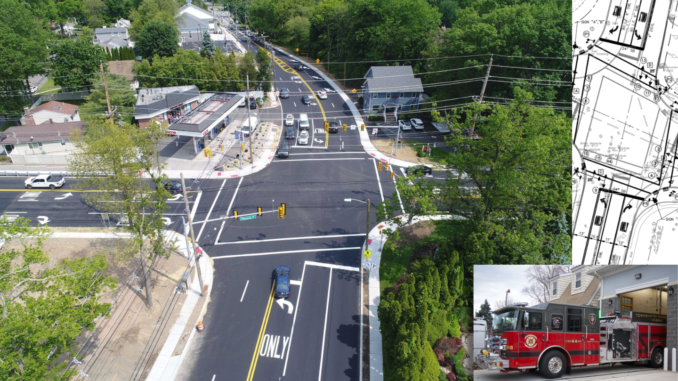
TOWNSHIP OF WASHINGTON—Bergen County engineering officials said that they would be moving back the stop-line striping for the left-hand-turn lane on Pascack Road heading north by an additional 5–6 feet to allow large emergency vehicles — such as the township’s new 100-foot long fire apparatus — to make the turn easier.
That’s according to Mayor Peter Calamari, giving his council update at the June 27 council meeting. Calamari said a recent email from county engineers informed him of the change, which was made following a few trial runs with the fire department’s new Pierce aerial ladder fire truck.
Calamari said the Boswell Engineering email he received was responding to recent council and resident criticisms of intersection problems raised at a June 13 council meeting. (See “New grief at township traffic crossing,” June 9, 2023.)
He said that Boswell reported the no-turn-on-red prohibition at all four approaches to the vital intersection was based on federal roadway design guidelines that state allowing right on red makes an intersection less safe for pedestrians, although it might decrease vehicle delays.
Councilman Tom Sears later noted that he only observed one pedestrian crossing the intersection during several hours on a recent morning. He conceded more pedestrians might be present when the commuter lot reopens.
Calamari said Boswell also said that the county agreed to a signage revision for southbound Pascack Road traffic to help reduce driver confusion when approaching the intersection, and that Boswell addressed concerns that vehicles were speeding up to merge while heading east on Washington Avenue past the intersection and possibly causing more accidents.
He said Boswell noted the two through-lanes were “absolutely necessary to improve the level of service and reduce delays.” They also noted that the two through-lanes merging required a normal driver maneuver in terms of merging, which requires the driver in the dropped lane to yield. They noted this situation “does not compromise safety.”
Calamari said Boswell responded, “The design is based on federal, county and state standards,” and that “the goal is to make the intersection safe for the traveling public and reduce traffic-related delays.”
The written responses were provided by Boswell Engineering engineer John Yakimic, said Calamari. Boswell is the township’s longtime consulting engineer. The county-financed improvements were made incrementally over the last 10 months, beginning last summer.
Previously, the township had purchased multiple property easements at the intersection before the long-awaited county intersection improvement project commenced.
Kennedy Road update
Calamari read from township administrator Mark DiCarlo’s report. DiCarlo was absent June 27.
Addressing resident Michael Ullman’s prior concern, DiCarlo’s report addressed conditions on Kennedy Road, noting it was repaved in 2016, in fairly good condition, with some cracks in the middle of the road due to underground water.
DiCarlo’s report said township consulting engineer John Yakimic, Boswell Engineering, did not consider the condition hazardous. Yakimic said three factors affect the lifespan of a surfaced road: traffic, presence of groundwater, and the chemical mix of the asphalt.
Generally, roadway resurfacing involves milling down two inches and resurfacing with two inches of asphalt. He said specs for roads where underground water is present should call for under drains. In 2023, Clark Road is due for resurfacing and under drains will be installed due to underground water there, according to DiCarlo’s report.
He noted during roadway resurfacing, Boswell engineers inspect the asphalt to help identify sub-standard mixtures. By law, contractors must provide a two-year maintenance bond, DiCarlo reported.
Moreover, the DPW is soliciting estimates for removal of a dead tree and branches in Clark Field due to safety concerns, the report noted.
